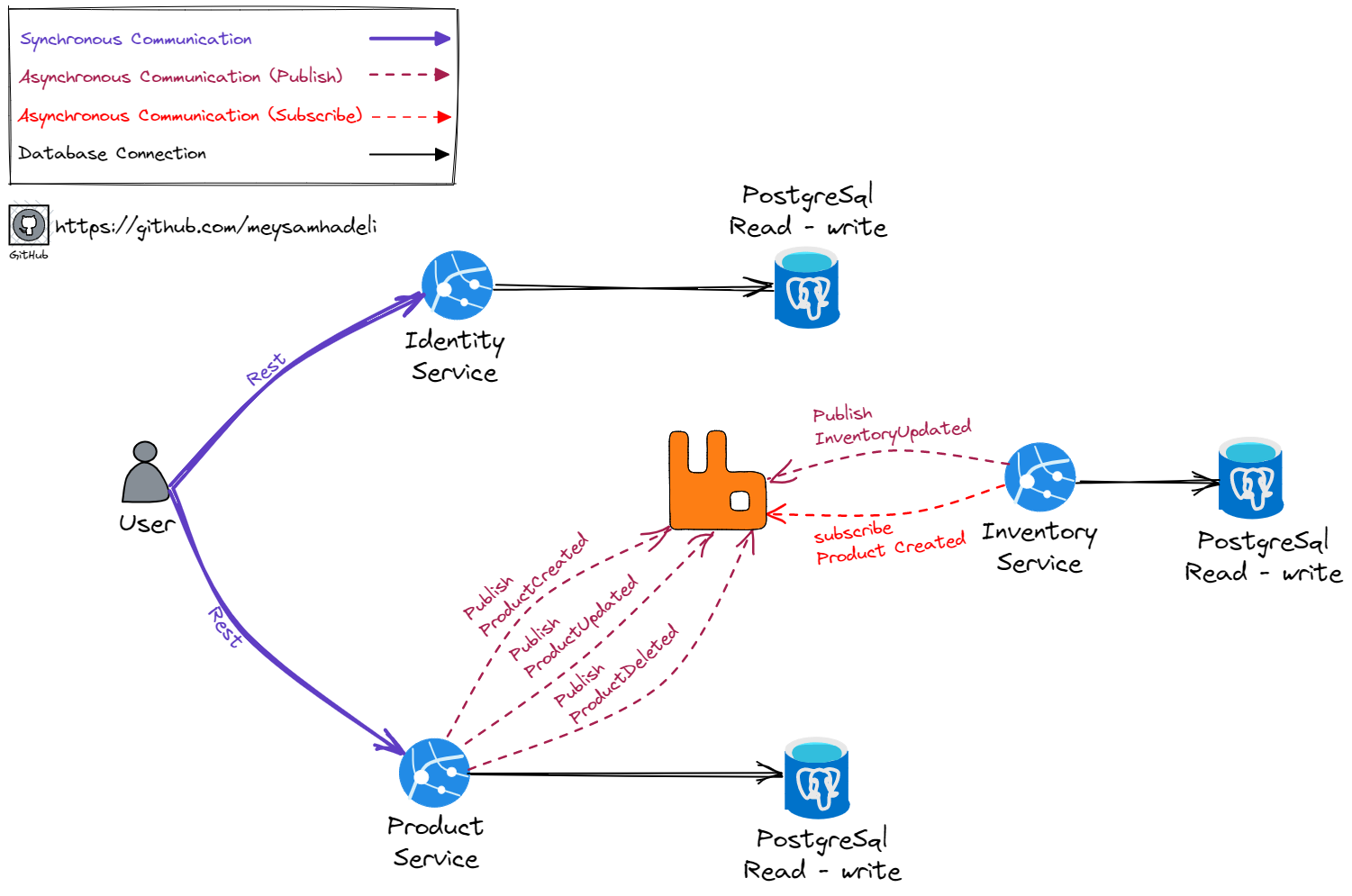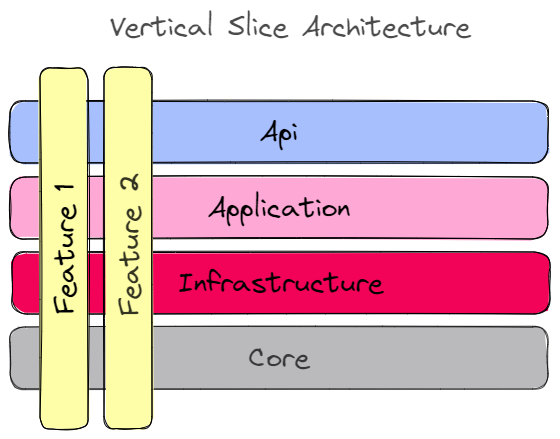The main idea of creating this project is implementing an infrastructure for up and running distributed system with the latest technology and architecture like Vertical Slice Architecture, OpenTelemetry, RabbitMq in Golang, and we will not deal mainly with business. 🚀
- ❇️ Using
Vertical Slice Architectureforarchitecture level. - ❇️ Using
RabbitmqforEvent Driven Architecturebetween our microservices withstreadway/amqplibrary. - ❇️ Using
gRPCforinternal communicationbetween our microservices withgrpc/grpc-golibrary. - ❇️ Using
CQRSimplementation withmehdihadeli/Go-MediatRlibrary. - ❇️ Using
Postgresfordatabasein our microservices withgo-gorm/gormlibrary. - ❇️ Using
go-playground/validatorforvalidating inputdata in the REST calls. - ❇️ Using
OpenTelemetryfordistributed tracingwithopen-telemetry/opentelemetry-golibrary. - ❇️ Using
OAuth2for implementationauthenticationandauthorizationwithgo-oauth2/oauth2library. - ❇️ Using
Echo frameworkforRESTFul api. - ❇️ Using
Swaggerwithswaggo/swaglibrary for api documentation. - ❇️ Using
uber-go/fxlibrary fordependency injection. - ❇️ Using
Viperforconfiguration management. - ❇️ Using
logrusas astructured logger. - ❇️ Using
Unit Testing,Integration TestingandEnd To End Testingfor testing level. - ❇️ Using
Docker-Composefor ourdeploymentmechanism.
🌀This project is a work in progress, new features will be added over time.🌀
I will try to register future goals and additions in the Issues section of this repository.
- ✔️
labstack/echo- High performance, minimalist Go web framework - ✔️
go-gorm/gorm- The fantastic ORM library for Go, aims to be developer friendly - ✔️
sirupsen/logrus- Logrus is a structured logger for Go - ✔️
streadway/amqp- Go RabbitMQ Client Library - ✔️
spf13/viper- Go configuration with fangs - ✔️
swaggo/echo-swagger- Echo middleware to automatically generate RESTful API documentation - ✔️
mehdihadeli/Go-MediatR- This package is a Mediator Pattern implementation in Go - ✔️
go-playground/validator- Implements value validations for structs and individual fields based on tags - ✔️
open-telemetry/opentelemetry-go- Implementation of OpenTelemetry in Go for distributed-tracing - ✔️
meysamhadeli/problem-details- Error Handler for mapping our error to standardized error payload to client - ✔️
go-resty/resty- Simple HTTP and REST client library for Go (inspired by Ruby rest-client) - ✔️
grpc/grpc-go- The Go language implementation of gRPC. HTTP/2 based RPC - ✔️
go-oauth2/oauth2- An open protocol to allow secure authorization in a simple and standard method - ✔️
stretchr/testify- A toolkit with common assertions and mocks that plays nicely with the standard library - ✔️
uber-go/fx- Fx is a dependency injection system for Go - ✔️
cenkalti/backoff- This is a Go port of the exponential backoff algorithm - ✔️
stretchr/testify- A toolkit with common assertions and mocks that plays nicely with the standard library - ✔️
testcontainers/testcontainers-go- it's a package to create and clean up container for automated integration/smoke tests - ✔️
avast/retry-go- Simple golang library for retry mechanism - ✔️
ahmetb/go-linq- .NET LINQ capabilities in Go
In this project I used vertical slice architecture and feature folder structure to structure my files.
I used RabbitMQ as my MessageBroker for async communication between microservices using the eventual consistency mechanism.
Microservices are event based which means they can publish and/or subscribe to any events occurring in the setup. By using this approach for communicating between services, each microservice does not need to know about the other services or handle errors occurred in other microservices.
I treat each request as a distinct use case or slice, encapsulating and grouping all concerns from front-end to back.
When adding or changing a feature in an application in n-tire architecture, we are typically touching many "layers" in an application. We are changing the user interface, adding fields to models, modifying validation, and so on. Instead of coupling across a layer, we couple vertically along a slice. We minimize coupling between slices, and maximize coupling in a slice.
With this approach, each of our vertical slices can decide for itself how to best fulfill the request. New features only add code, we're not changing shared code and worrying about side effects.
Instead of grouping related action methods in one endpoint, I used the REPR pattern. Each action gets its own small endpoint, and for communication between our endpoint and handlers, I use Go-MediatR for decouple our endpoint to handlers directly, and it gives use some pipeline behavior for logging, caching, validation and... easily.
The use of the mediator pattern in my endpoints creates clean and thin endpoint. By separating action logic into individual handlers we support the Single Responsibility Principle and Don't Repeat Yourself principles, this is because traditional controllers tend to become bloated with large action methods and several injected Services only being used by a few methods.
I used CQRS to decompose my features into small parts that makes our application:
- Maximize performance, scalability and simplicity.
- Easy to maintain and add features to. Changes only affect one command or query, avoiding breaking changes or creating side effects.
- It gives us better separation of concerns and cross-cutting concern (with help of mediatr behavior pipelines), instead of bloated service classes doing many things.
Using the CQRS pattern, we cut each business functionality into vertical slices, for each of these slices we group classes (see technical folders structure) specific to that feature together (command, handlers, infrastructure, repository, controllers, etc). In our CQRS pattern each command/query handler is a separate slice. This is where you can reduce coupling between layers. Each handler can be a separated code unit, even copy/pasted. Thanks to that, we can tune down the specific method to not follow general conventions (e.g. use custom postgresql query or even different storage). In a traditional layered architecture, when we change the core generic mechanism in one layer, it can impact all methods.
If you like my work, feel free to:
- ⭐ this repository. And we will be happy together :)
Thanks a bunch for supporting me!
Thanks to all contributors, you're awesome and this wouldn't be possible without you! The goal is to build a categorized community-driven collection of very well-known resources.
Please follow this contribution guideline to submit a pull request or create the issue.
- https://github.com/golang-standards/project-layout
- https://github.com/AleksK1NG/Go-Elasticsearch-RabbitMQ
- https://github.com/ThreeDotsLabs/wild-workouts-go-ddd-example
- https://github.com/kgrzybek/modular-monolith-with-ddd
- https://github.com/jbogard/ContosoUniversityDotNetCore-Pages
This project is made available under the MIT license. See LICENSE for details.


